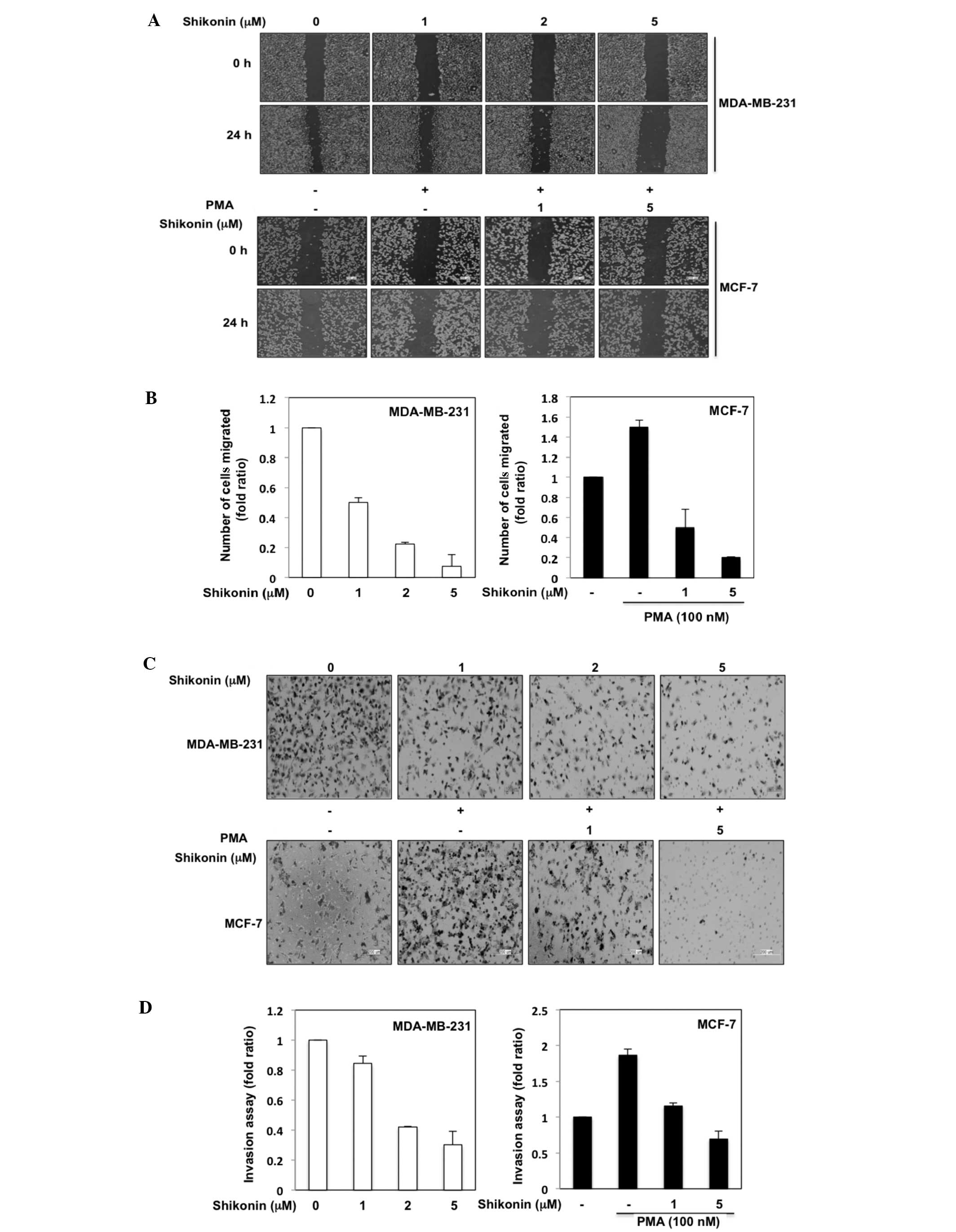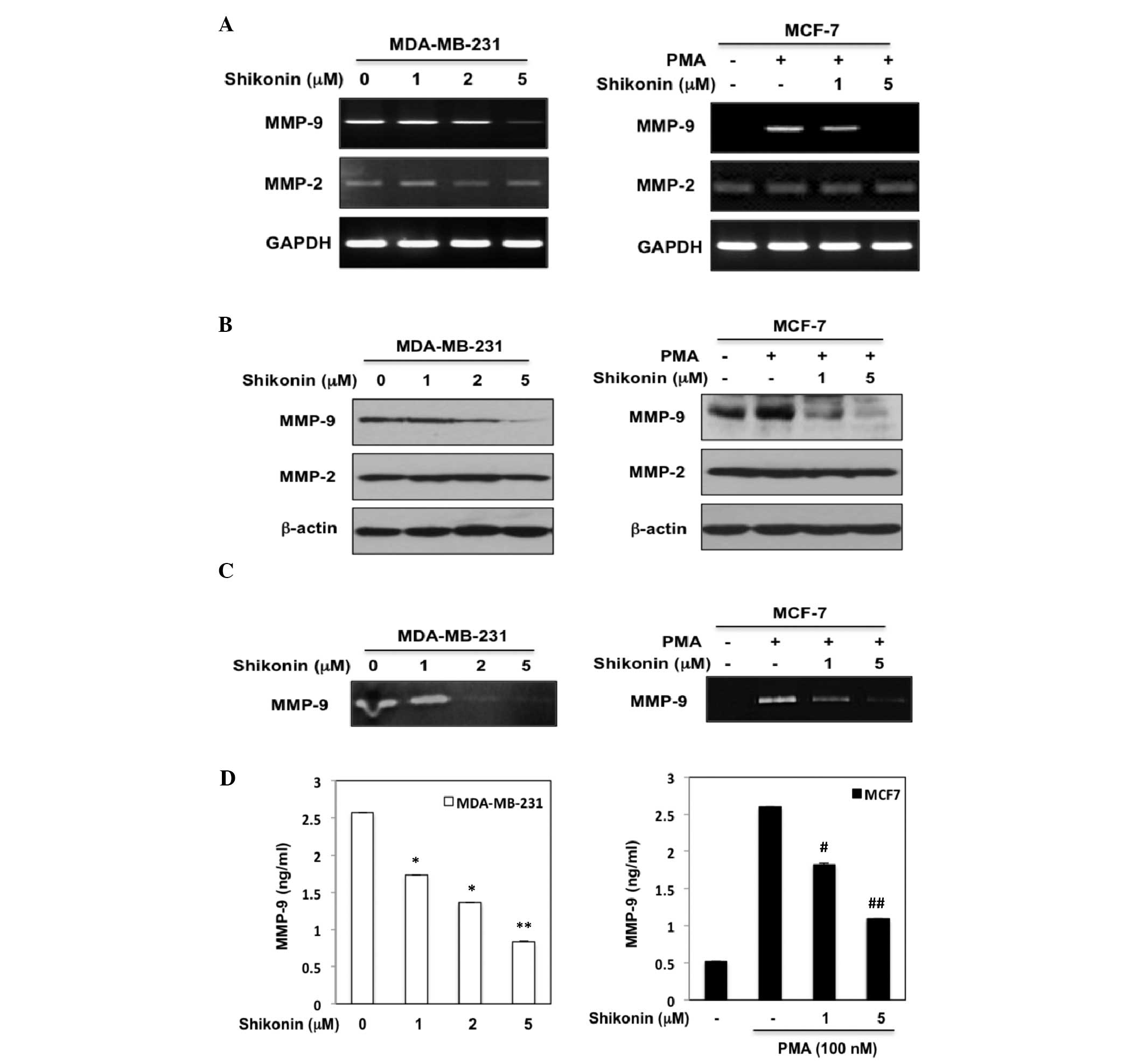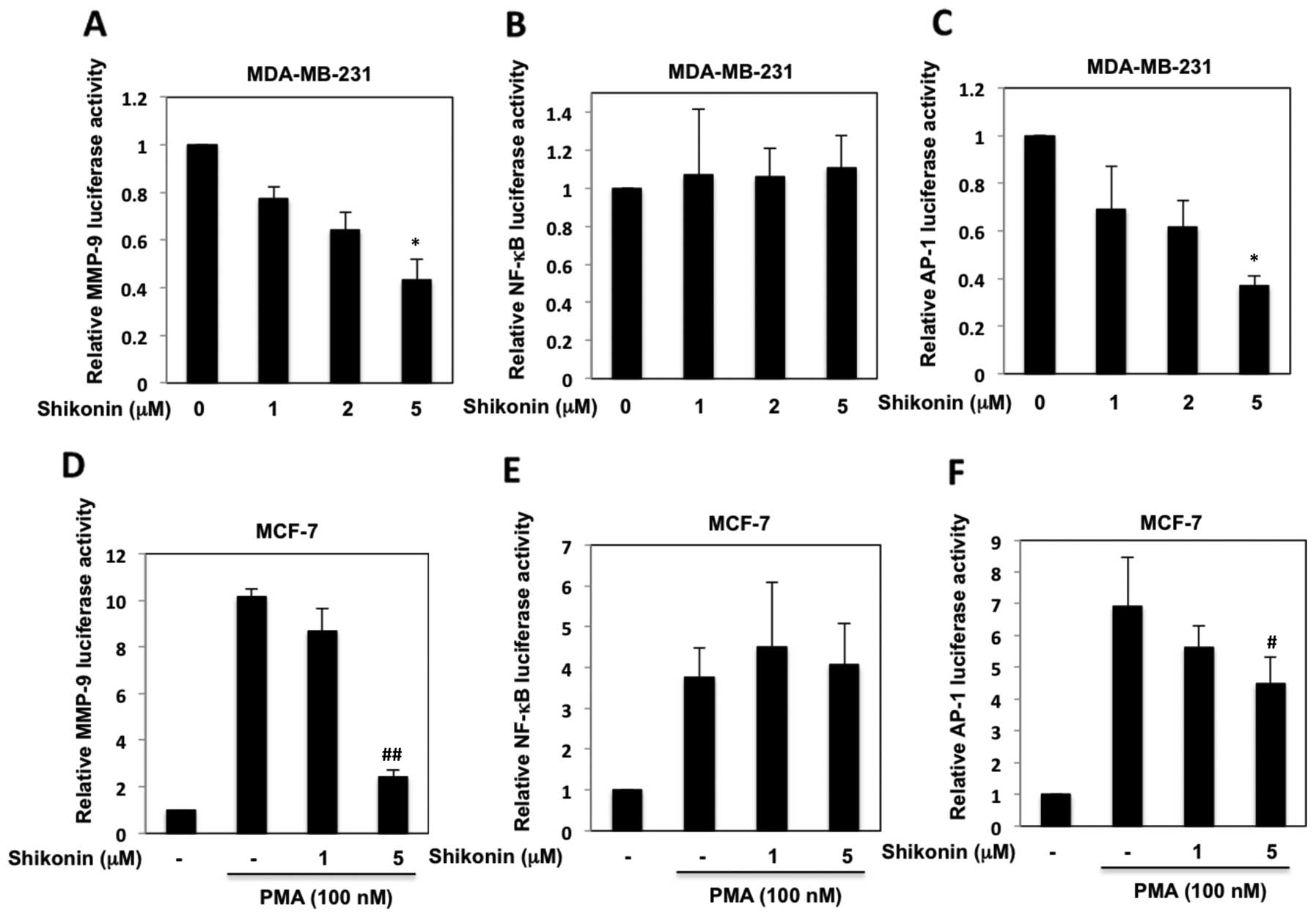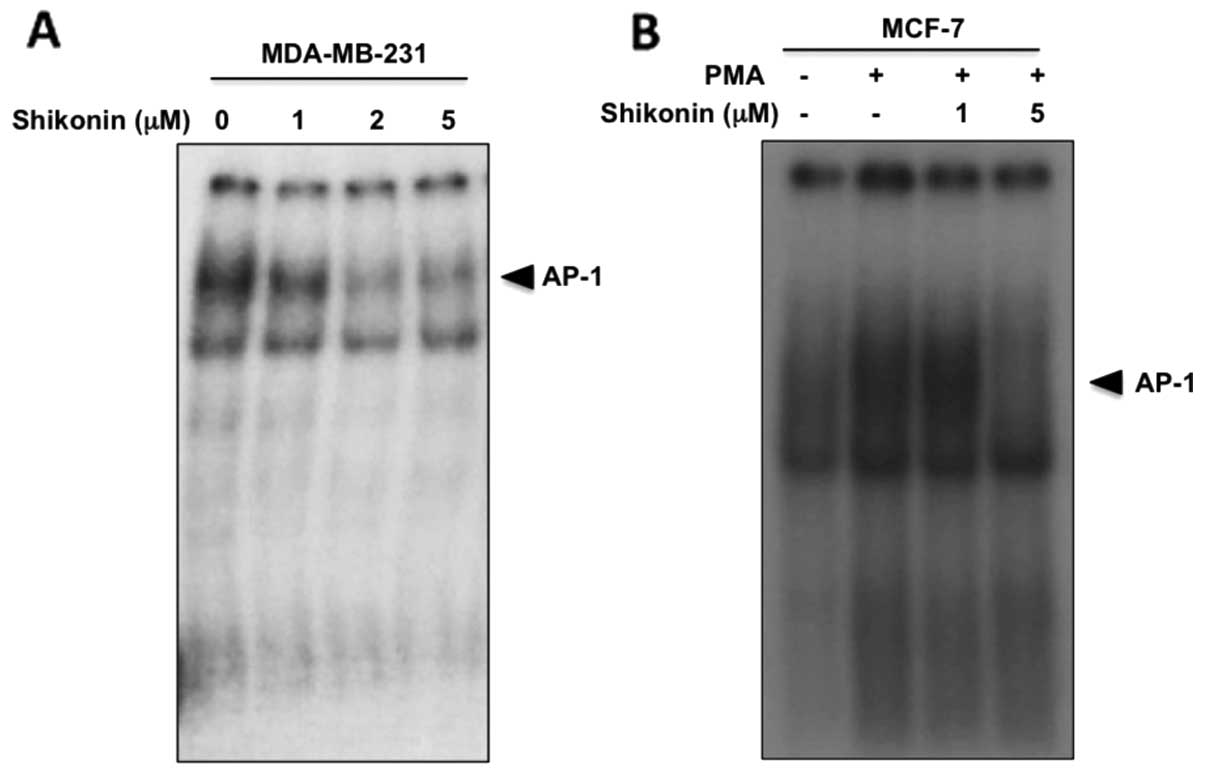Introduction
Breast cancer ranks among the most common malignant
tumors afflicting women worldwide (1). Cancer metastasis is the leading cause
of mortality in patients with breast cancer; breast cancer survival
rates fall from 90% for localized to 20% for metastatic disease.
Therefore, controlling metastasis and invasion represents an
important therapeutic strategy (2).
Metastasis requires that invasive cells detach from localized
tumors by degrading the extracellular matrix using proteases,
including matrix metalloproteinases (MMPs); survive in the
circulation as circulating tumor cells (CTCs); and colonize distant
locations. Thus, understanding the molecular mechanisms underlying
each of these steps is essential for targeting metastatic cells at
an early stage and improving patient survival (3).
MMPs are a family of extracellular matrix
(ECM)-degrading enzymes comprising 24 members. Based on their
substrates, MMPs are divided into four subclasses: collagenase,
gelatinase, stromelysin and membrane-associated (4). As a main ECM-degrading enzyme family,
MMPs have essential roles in physiologic processes such as tissue
development, remodeling and wound healing (5). However, they are also involved in
certain tissue destructive diseases, such as atherosclerosis,
inflammation, rheumatoid arthritis, and tumor invasion, metastasis
and neoangiogenesis (6). Recent
studies have shown that MMPs are important elements of the tumor
microenvironment, regulating tumor progression, metastatic niche
formation and inflammation in cancer (7). Among human MMPs, MMP-2 (gelatinase-A)
and MMP-9 (gelatinase-B) are key enzymes in the degradation of type
IV collagen, which is an important component of the ECM. MMP-2 and
MMP-9 are the MMP members primarily associated with tumor
migration, invasion and metastasis of various types of cancers
(8). It has been shown that
enhanced expression of MMP-9 is associated with the progression and
invasion of tumors, whereas MMP-2 is usually expressed
constitutively (9,10). Thus, researchers have focused on
discovering inhibitors of MMP activity as a strategy for
suppressing tumorigenesis and metastasis.
Shikonin is an active naphthoquinone compound and
the main component of red pigment extracts from the Chinese
medicinal herb, Lithospermum erythrorhizon Sieb et Zucc.
Shikonin and its analogues can kill cancer cells through a number
of mechanisms, including inhibition of topoisomerase-I (11), polo-like kinase 1 (PLK1) and protein
tyrosine kinase (PTK) (12);
regulation of phosphorylation-dependent activities of
extracellular-regulated protein kinase (pERK), c-Jun N-terminal
kinase (JNK) and protein kinase Ca (PKCa) (13); suppression of tumor necrosis factor
receptor-associated protein 1 (TRAP1) expression (14); activation of caspases (15); and inhibition of proteasome activity
(16). In previous studies,
shikonin and its derivatives were shown to exert antiproliferative
and pro-apoptotic effects against a number of tumor cells,
including sarcoma 180 (S-180) ascites cells, gastric cancer, colon
adenocarcinoma and oral cancer (17). A recent report also showed that
shikonin activates the p53 and caspase-9 pathways (18) in human malignant melanoma A375-S2
cells. However, little is known concerning its anti-invasion
effects in human breast cancer cell lines. In the present study, we
investigated the anti-invasion effects of shikonin and explored the
possible molecular mechanisms in breast cancer using the human
breast cancer cell lines, MDA-MB-231 and MCF-7. We showed that
shikonin inhibits the migration and invasion of breast cancer cells
by suppressing AP-1 transcription factor-mediated MMP-9
expression.
Materials and methods
Materials and reagents
Shikonin was purchased from Sigma (St. Louis, MO,
USA) and antibodies against MMP-2 and MMP-9 were purchased from
Calbiochem (Boston, MA, USA). Antibodies against PCNA and p65 were
purchased from Santa Cruz Biotechnology Inc. (Santa Cruz, CA, USA).
MMP-9 ELISA kits were purchased from R&D Systems (Abingdon,
UK).
Cell line and cell culture
Human breast cancer cell lines, MCF-7 and
MDA-MB-231, were used in the present study. Cells were grown in
RPMI-1640 medium supplemented with 10% fetal bovine serum
(FBS).
Transwell invasion assays
The invasion of tumor cells was assessed in
Transwell chambers. A Transwell membrane (8-μm pore size, 6.5-mm
diameter; Corning Costar Corporation) was used. A Transwell
membrane coated with Matrigel (100 μg/ml, 100 μl/well) was used for
the invasion assay. Cells were seeded onto the upper wells in the
presence of different concentrations of shikonin. The bottom
chambers of the Transwell were filled with conditioned medium.
After incubation for 24 h, cells were fixed, stained and counted
under a light microscope.
In-gel zymography
The MMP activities were assayed as previously
described (19). Briefly,
5×105 cells in a 6-well plate were seeded and maintained
in serum-free medium for 16–24 h. The conditioned medium was
separated on a sodium dodecyl sulfate-polyacrylamide gel
electrophoresis gel containing 1 mg/ml gelatin. The gel was washed
with buffer I [Tris-HCl (pH 7.5) and 2.5% Triton X-100)], incubated
overnight in buffer II [150 mM NaCl, 5 mM CaCl2, 50 mM
Tris-HCl (pH 7.6)] at 37°C and stained with Coomassie blue. The
clear bands indicate where MMPs degraded gelatin.
Cell migration assay
Migration was assessed by a wound healing assay.
Cells were seeded at 2×104 MCF-7 and MDA-MB-231
cells/well. After scraping the cell monolayer with a sterile
micropipette tip, the wells were washed with serum-free medium
several times with different concentrations of shikonin. The first
image of each scratch was acquired at time zero. At 24 h, each
scratch was examined and captured at the same location and the
healed area was measured.
Western blotting
Cells were washed twice with 1X PBS, and cell
extracts were prepared using RIPA buffer (1X PBS, 1% NP-40, 0.5%
sodium deoxycholate, 0.1% SDS containing an additional 100 ml of 10
mg/ml PMSF, and 1 Complete Mini Protease Inhibitor tablet). Lysate
proteins were resolved by SDS-PAGE and transferred using
nitrocellulose membranes (Whatman Protran BA83; 0.2 μm) The
membranes were incubated with TBS buffer containing 0.1% Tween-20
and 5% skim milk, and then exposed to the desired primary antibody.
After treatment with the proper secondary antibody, the
immunoreactive bands were visualized using standard ECL (Pierce,
Rockford, IL, USA) method.
Reverse transcription-PCR
In the reverse transcription-PCR (RT-PCR) analysis,
total RNA was extracted from the treated cells. For reverse
transcription reaction, cDNA was synthesized from 1 μg of total RNA
using the High Capacity cDNA synthesis kit (Applied Biosystems).
The PCR primers used were as follows: MMP-9 sense,
5′-TTTGACAGCGACAAGA AGTGG-3′ and MMP-9 antisense, 5′-TCCCATCCTTGAAC
AAATACA-3′; MMP-2 sense, 5′-CATTCCGCTTCCAGGG CACAT-3′ and MMP-2
antisense, 5′-GCTCCTGAATGCCCT TGAGTCA-3′; GAPDH sense,
5′-GCCATCGTCACCAAC TGGGAC-3′ and GAPDH antisense, 5′-CGATTTCCCGCT
CGGCCGTGG-3′. PCR products were analyzed by agarose gel
electrophoresis and visualized by treatment with ethidium
bromide.
Electrophoretic mobility shift assay
(EMSA)
The oligonucleotides were labeled with
[γ-32P] ATP and incubated with nuclear extracts for 30
min by using the Gel Shift Assay kit (Promega Corp., Madison, WI,
USA). The DNA-protein complexes were resolved on non-denaturing and
non-reducing 6% acrylamide gels. The probes used for EMSA were as
follows. Probe for AP-1, 5′-CGC TTG ATG ACT CAG CCG GAA-3′.
Statistical analysis
The results are presented as mean ± SE, and
statistical comparisons between groups were carried out using
one-way ANOVA followed by the Student’s t-test. P≤0.05 was
considered to indicate a statistically significant result.
Results
Effects of shikonin on the migration and
invasion of breast cancer cells
To investigate the effects of shikonin on human
breast cancer cell migration and invasion, we treated MDA-MB-231
cells with different concentrations of shikonin (1–5 μM) and
performed wound healing and Matrigel-based Transwell invasion
assays. As shown in Fig. 1,
shikonin significantly inhibited MDA-MB-231 cancer cell migration
by ~80% and invasion by ~60%. Moreover, shikonin induced a
concentration-dependent inhibition of PMA-induced migration and
invasion of MCF-7 cells. MCF-7 cells treated with PMA presented a
1.5-fold increase in migration (Fig. 1A
and B). However, treatment with 5 μM shikonin inhibited
PMA-induced migration by ~70% in the MCF-7 cancer cell line
(Fig. 1A and B). We next examined
whether shikonin inhibits PMA-induced invasion in MCF-7 cells. PMA
induced a 2-fold increase in the invasion of MCF-7 cells, while
shikonin inhibited this invasion by ~60% at a 5 μM dose (Fig. 1C and D). These data imply that
shikonin is an effective inhibitor of breast cancer cell migration
and invasion.
Shikonin inhibits MMP-9 expression and
proteolytic activity
MMP-9 and MMP-2 are important ECM-degrading enzymes
that are reported to be involved in cancer cell invasion and
metastasis (20). On the basis of
these observations and the foregoing data, we examined the effect
of shikonin on the expression of both MMP-2 and MMP-9 in MDA-MB-231
cells; we also investigated PMA-induced MMP-9 expression in MCF-7
cells. Following treatment with shikonin, MMP-9 expression in the
MDA-MB-231 cells gradually decreased over time at both the mRNA and
protein levels (Fig. 2A and B).
Shikonin also significantly inhibited PMA-induced expression of
both MMP-9 mRNA and protein in the MCF-7 cells. However, neither
PMA nor shikonin treatment affected MMP-2 mRNA or protein
expression (Fig. 2A and B). We next
examined MMP-2 and MMP-9 secretion and activity using gelatin
zymography and enzyme-linked immunosorbent assays (ELISAs),
respectively. MMP-9 secretion measured in the MDA-MB-231
cell-conditioned medium was significantly reduced by shikonin
(Fig. 2C and D). Similarly,
shikonin inhibited PMA-induced MMP-9 activity in the MCF-7 cells.
These results indicate that shikonin is involved in the regulation
of proteolytic activity as well as expression of MMP-9.
Shikonin inhibits transcriptional
activity of MMP-9 by suppressing AP-1 binding
To explain the molecular mechanism underlying the
inhibitory effects of shikonin on MMP-9 expression, we investigated
the possible regulation of MMP-9 at the transcriptional level. The
MMP-9 promoter contains two AP-1 binding sites and a nuclear factor
(NF)-κB binding site, and it has been shown that NF-κB and AP-1
play critical roles in regulating basal and cytokine-induced MMP-9
expression in many cancer cell lines (19). Therefore, we examined whether
shikonin inhibits MMP-9 expression through an effect on NF-κB or
AP-1 binding sites in the MMP-9 promoter. Human breast cancer
cells, MDA-MB-231 and MCF-7, were transiently transfected with the
MMP-9 promoter construct. As shown in Fig. 3A, MMP-9 promoter activity was
decreased in a dose-dependent manner following shikonin treatment
in MDA-MB-231 cells. We also, confirmed that the MMP-9 promoter was
activated up to ~10-fold in the PMA-treated MCF-7 cells. Shikonin
showed a dose-dependent inhibition of PMA-induced MMP-9 promoter
activity in the MCF-7 cells (Fig.
3D). Next, we examined whether shikonin affects the
transcriptional activity of NF-κB and AP-1, critical modulators of
MMP-9 activity. MDA-MB-231 cells were transiently transfected with
AP-1 report vectors and then treatment of shikonin was carried out
at different doses. As shown in Fig.
3C, AP-1 promoter activity was significantly reduced in the
range of 1–5 mM of shikonin. In addition, MCF-7 cells were
transiently transfected with reporter vectors containing tandem
repeats of the AP-1 binding site to confirm the specificity of the
shikonin-mediated inhibitory effect on AP-1. Treatment with PMA led
to an ~7-fold increase in AP-1 promoter activity; notably, this
stimulatory effect of PMA was significantly reduced by treatment
with shikonin (Fig. 3F). However,
NF-κB promoter activity exhibited significant change in the
MDA-MB-231 and MCF-7 cells (Fig. 3B and
E). These results suggest that shikonin inhibits MMP-9 activity
through suppression of AP-1-mediated MMP-9 transcription in breast
cancer cells.
Shikonin decreases transcription factor
binding to the AP-1 motif in the MMP-9 promoter region
Next, we examined whether shikonin inhibits the
transcriptional binding activity of AP-1 to its DNA motifs in
MDA-MB-231 cells using electrophoretic gel mobility shift assay
(EMSA). MDA-MB-231 cells were treated with different dose of
shikonin for 24 h and nuclear extracts were prepared. As shown in
Fig. 4A, shikonin significantly
decreased AP-1 DNA binding activity. Subsequently, we examined
whether the subunit of AP-1 transcription factor is regulated by
shikonin. Expression levels of c-Fos and c-Jun, subunits of AP-1,
were significantly reduced by shikonin treatment (Fig. 4C). Similar results were observed in
MCF-7 cells. MCF-7 cells were pretreated with different
concentrations of shikonin with 100 nM PMA. Then, nuclear extracts
were prepared and analyzed for AP-1 DNA binding activities. As
shown in Fig. 4B, shikonin
significantly decreased PMA-induced AP-1 DNA binding ability. To
determine which subunit of the AP-1 transcription factor is
regulated by shikonin, we examined the expression levels of c-Fos
and c-Jun following shikonin treatment. Our data showed that
shikonin significantly reduced PMA-induced c-Jun and c-Fos
expression but had little effect on the expression of p65 in the
western blot assays (Fig. 4D).
These results suggest that shikonin inhibits AP-1 transcription
activity by suppressing its subunit expression.
Discussion
Members of the MMP family, in particular, MMP-9, are
associated with regulation of cancer cell invasion and metastasis,
the most insidious and life-threating aspects of cancer (21,22).
Therefore, the development of compounds capable of inhibiting MMP-9
could prove invaluable in the treatment of breast cancer patients.
Shikonin has previously been shown to possess antiproliferative and
pro-apoptotic activity in a number of tumor cells, but there is
little information concerning its effects on tumor invasion
(23). In the present study, we
showed that shikonin effectively inhibited the migration and
invasion of human breast cancer cells. We also found that shikonin
inhibited the expression of MMP-9 in breast cancer cells, thereby
reducing its proteolytic activity. These data suggest that shikonin
suppresses the metastatic phenotype of human breast cancer cells
via downregulation of MMP-9 expression. Previous studies have
reported that the MMP-9 promoter contains a number of transcription
factor-binding motifs, including those for NF-κB and AP-1 (24). The activity of the MMP-9 promoter is
induced by AP-1 and/or NF-κB (25,26),
which are two key transcription factors involved in the regulation
of MMP-9 gene expression (24).
Regulation of these transcription factors is also critically
involved in the process of tumor metastasis. AP-1 is composed of
members of the c-Jun and c-Fos families (27–29).
Upon activation of AP-1, they associate to form a variety of
homodimers and heterodimers that localize to the nucleus and
regulate gene expression. Our results showed that shikonin
decreased nuclear c-Fos and c-Jun, without affecting p65. These
data suggest that the inhibitory effect of shikonin on AP-1 is
responsible for shikonin-induced inhibition of MMP-9
expression/activity, and subsequent suppression of invasion.
In summary, we demonstrated that shikonin inhibits
human breast cancer cell migration and invasion by suppressing
MMP-9 activity by blocking the activation of AP-1 transcription
factors. Therefore, we conclude that shikonin is a potential
therapeutic agent that may be valuable in preventing the metastasis
of several types of human cancers, including breast cancer.
Acknowledgements
This research was supported by the grant from Basic
Science Research Program through the National Research Foundation
of Korea grant funded by the Ministry of Education, Science, and
Technology of the Korea government (2011-0010430).
References
|
1
|
Jemal A, Siegel R, Ward E, Hao Y, Xu J and
Thun MJ: Cancer statistics, 2009. CA Cancer J Clin. 59:225–249.
2009. View Article : Google Scholar
|
|
2
|
Cho HJ, Kang JH, Kwak JY, et al:
Ascofuranone suppresses PMA-mediated matrix metalloproteinase-9
gene activation through the Ras/Raf/MEK/ERK- and Ap1-dependent
mechanisms. Carcinogenesis. 28:1104–1110. 2007. View Article : Google Scholar : PubMed/NCBI
|
|
3
|
Wang X, Lu H, Urvalek AM, et al: KLF8
promotes human breast cancer cell invasion and metastasis by
transcriptional activation of MMP9. Oncogene. 30:1901–1911. 2011.
View Article : Google Scholar : PubMed/NCBI
|
|
4
|
Yan C and Boyd DD: Regulation of matrix
metalloproteinase gene expression. J Cell Physiol. 211:19–26. 2007.
View Article : Google Scholar : PubMed/NCBI
|
|
5
|
Nagase H and Woessner JF Jr: Matrix
metalloproteinases. J Biol Chem. 274:21491–21494. 1999. View Article : Google Scholar
|
|
6
|
Egeblad M and Werb Z: New functions for
the matrix metalloproteinases in cancer progression. Nat Rev
Cancer. 2:161–174. 2002. View
Article : Google Scholar : PubMed/NCBI
|
|
7
|
Kessenbrock K, Plaks V and Werb Z: Matrix
metalloproteinases: regulators of the tumor microenvironment. Cell.
141:52–67. 2010. View Article : Google Scholar : PubMed/NCBI
|
|
8
|
Chambers AF and Matrisian LM: Changing
views of the role of matrix metalloproteinases in metastasis. J
Natl Cancer Inst. 89:1260–1270. 1997. View Article : Google Scholar : PubMed/NCBI
|
|
9
|
Scorilas A, Karameris A, Arnogiannaki N,
et al: Overexpression of matrix-metalloproteinase-9 in human breast
cancer: a potential favourable indicator in node-negative patients.
Br J Cancer. 84:1488–1496. 2001. View Article : Google Scholar : PubMed/NCBI
|
|
10
|
Nabeshima K, Inoue T, Shimao Y and
Sameshima T: Matrix metalloproteinases in tumor invasion: role for
cell migration. Pathol Int. 52:255–264. 2002. View Article : Google Scholar : PubMed/NCBI
|
|
11
|
Bailly C: Topoisomerase I poisons and
suppressors as anticancer drugs. Curr Med Chem. 7:39–58. 2000.
View Article : Google Scholar : PubMed/NCBI
|
|
12
|
Masuda Y, Nishida A, Hori K, et al:
β-hydroxyisovaleryl shikonin induces apoptosis in human leukemia
cells by inhibiting the activity of a polo-like kinase 1 (PLK1).
Oncogene. 22:1012–1023. 2003.
|
|
13
|
Kim SH, Kang IC, Yoon TJ, et al: Antitumor
activities of a newly synthesized shikonin derivative,
2-hyim-DMNQ-S-33. Cancer Lett. 172:171–175. 2001. View Article : Google Scholar : PubMed/NCBI
|
|
14
|
Masuda Y, Shima G, Aiuchi T, et al:
Involvement of tumor necrosis factor receptor-associated protein 1
(TRAP1) in apoptosis induced by β-hydroxyisovalerylshikonin. J Biol
Chem. 279:42503–42515. 2004.PubMed/NCBI
|
|
15
|
Yoon Y, Kim YO, Lim NY, Jeon WK and Sung
HJ: Shikonin, an ingredient of Lithospermum erythrorhizon
induced apoptosis in HL60 human premyelocytic leukemia cell line.
Planta Med. 65:532–535. 1999.
|
|
16
|
Yang H, Zhou P, Huang H, et al: Shikonin
exerts antitumor activity via proteasome inhibition and cell death
induction in vitro and in vivo. Int J Cancer.
124:2450–2459. 2009. View Article : Google Scholar : PubMed/NCBI
|
|
17
|
Gaddipati JP, Mani H, Shefali, et al:
Inhibition of growth and regulation of IGFs and VEGF in human
prostate cancer cell lines by shikonin analogue 93/637 (SA).
Anticancer Res. 20:2547–2552. 2000.PubMed/NCBI
|
|
18
|
Wu Z, Wu L, Li L, Tashiro S, Onodera S and
Ikejima T: p53-mediated cell cycle arrest and apoptosis induced by
shikonin via a caspase-9-dependent mechanism in human malignant
melanoma A375–S2 cells. J Pharmacol Sci. 94:166–176.
2004.PubMed/NCBI
|
|
19
|
Chung TW, Moon SK, Chang YC, et al: Novel
and therapeutic effect of caffeic acid and caffeic acid phenyl
ester on hepatocarcinoma cells: complete regression of hepatoma
growth and metastasis by dual mechanism. FASEB J. 18:1670–1681.
2004. View Article : Google Scholar : PubMed/NCBI
|
|
20
|
Hu B, Thirtamara-Rajamani KK, Sim H and
Viapiano MS: Fibulin-3 is uniquely upregulated in malignant gliomas
and promotes tumor cell motility and invasion. Mol Cancer Res.
7:1756–1770. 2009. View Article : Google Scholar : PubMed/NCBI
|
|
21
|
Huang W, Yu LF, Zhong J, et al:
Angiotensin II type 1 receptor expression in human gastric cancer
and induces MMP2 and MMP9 expression in MKN-28 cells. Dig Dis Sci.
53:163–168. 2008. View Article : Google Scholar : PubMed/NCBI
|
|
22
|
Jin H, Pan Y, He L, et al: p75
neurotrophin receptor inhibits invasion and metastasis of gastric
cancer. Mol Cancer Res. 5:423–433. 2007. View Article : Google Scholar : PubMed/NCBI
|
|
23
|
Min R, Zun Z, Min Y, Wenhu D, Wenjun Y and
Chenping Z: Shikonin inhibits tumor invasion via down-regulation of
NF-κB-mediated MMP-9 expression in human ACC-M cells. Oral Dis.
17:362–369. 2011.PubMed/NCBI
|
|
24
|
Sato T, Koike L, Miyata Y, et al:
Inhibition of activator protein-1 binding activity and
phosphatidylinositol 3-kinase pathway by nobiletin, a polymethoxy
flavonoid, results in augmentation of tissue inhibitor of
metalloproteinases-1 production and suppression of production of
matrix metalloproteinases-1 and −9 in human fibrosarcoma HT-1080
cells. Cancer Res. 62:1025–1029. 2002.PubMed/NCBI
|
|
25
|
Gum R, Lengyel E, Juarez J, et al:
Stimulation of 92-kDa gelatinase B promoter activity by ras is
mitogen-activated protein kinase kinase 1-independent and requires
multiple transcription factor binding sites including closely
spaced PEA3/ets and AP-1 sequences. J Biol Chem. 271:10672–10680.
1996. View Article : Google Scholar
|
|
26
|
Yokoo T and Kitamura M: Dual regulation of
IL-1 beta-mediated matrix metalloproteinase-9 expression in
mesangial cells by NF-kappa B and AP-1. Am J Physiol.
270:F123–F130. 1996.PubMed/NCBI
|
|
27
|
Matthews CP, Colburn NH and Young MR: AP-1
a target for cancer prevention. Curr Cancer Drug Targets.
7:317–324. 2007. View Article : Google Scholar
|
|
28
|
Milde-Langosch K: The Fos family of
transcription factors and their role in tumourigenesis. Eur J
Cancer. 41:2449–2461. 2005. View Article : Google Scholar : PubMed/NCBI
|
|
29
|
Ozanne BW, Spence HJ, McGarry LC and
Hennigan RF: Transcription factors control invasion: AP-1 the first
among equals. Oncogene. 26:1–10. 2007. View Article : Google Scholar : PubMed/NCBI
|


















